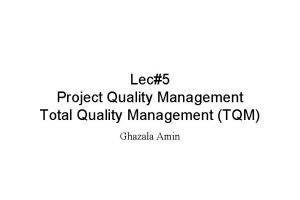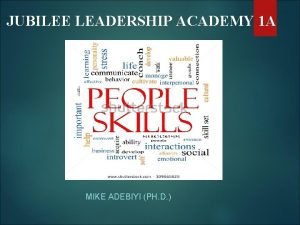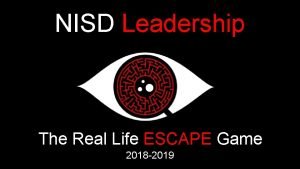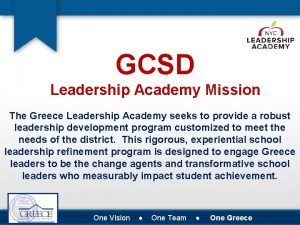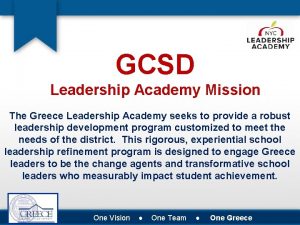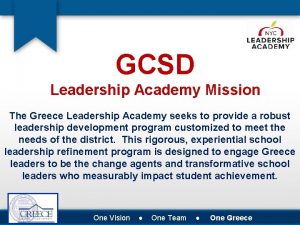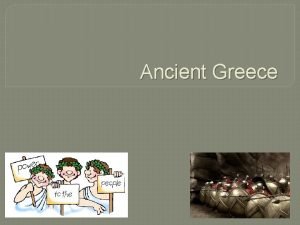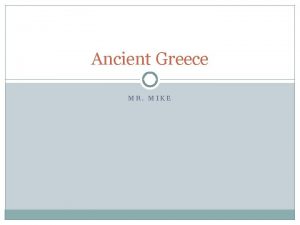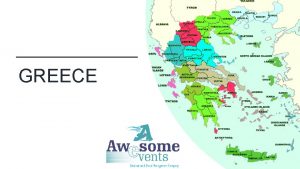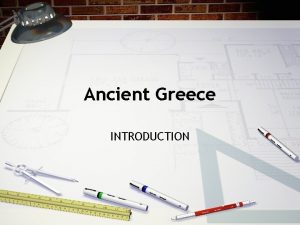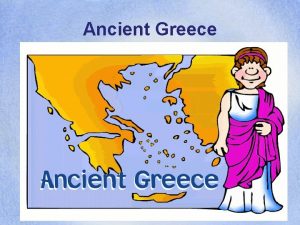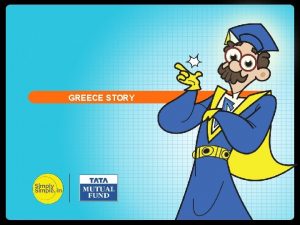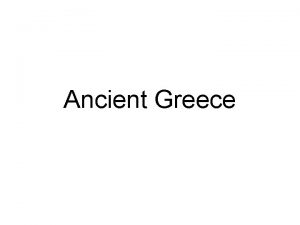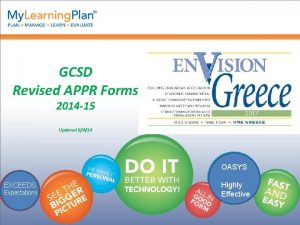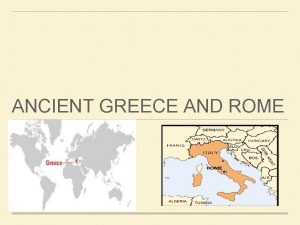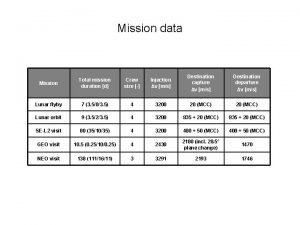GCSD Leadership Academy Mission The Greece Leadership Academy





![Go through the action steps Whip through the action steps [little squares] once and Go through the action steps Whip through the action steps [little squares] once and](https://slidetodoc.com/presentation_image_h2/b50e40414ab3d5772738b7172fa9833a/image-6.jpg)








































- Slides: 46

GCSD Leadership Academy Mission The Greece Leadership Academy seeks to provide a robust leadership development program customized to meet the needs of the district. This rigorous, experiential school leadership refinement program is designed to engage Greece leaders to be the change agents and transformative school leaders who measurably impact student achievement. One Vision ● One Team ● One Greece

Purpose Day 2 • Explore and develop Common Core implementation requirements to integrate in the School Improvement Plan. • Administrators understand how to use the Tri-State Rubric to monitor the implementation of the Common Core. • Administrators and Principals understand the Marzano standards and how they relate to practice. • To build the relationship between school community members One Vision ● One Team ● One Greece

Implementing the Common Core Day Two One Vision One Team One Greece

Purpose Explore and develop Common Core implementation requirements to integrate into school improvement plan, in school groups Create draft map of roll out of Common Core by school and identify priorities and action steps One Vision ● One Team ● One Greece

Overview Note the format of the action brief: • A primer on Common Core, shifts • Creating the argument, case for urgency • Series of “schoolwide changes” • Followed by Action Steps
![Go through the action steps Whip through the action steps little squares once and Go through the action steps Whip through the action steps [little squares] once and](https://slidetodoc.com/presentation_image_h2/b50e40414ab3d5772738b7172fa9833a/image-6.jpg)
Go through the action steps Whip through the action steps [little squares] once and put one star on those you want to review. Do not star all ideas! You do not have to star ANY ideas, if you have your own ideas. It should be silent.

Second round THEN go back. Together • Put two stars on all those the GROUP thinks might be a good idea. • Listen for emerging consensus.

Third Round • Go through the double stars. Ask: which of these have impact on student learning. • Which are aligned to your tentative school goals. • Come to ONE action step. This could be a combination of smaller actions suggested in the document. • You may have a few others you also want to do; put them to the side for now.

Action Planning • Look at the action plan template • How do your favored actions relate to potential school goals? • Is this action a potential strategy for achieving one of your school goals? • If it isn’t, should it be? [should you have a school goal of “implementing the CCSS? ]

Action Plan Sample • Read sample aloud • Answer Questions

Action plan • Make the who, what, and when clear. Who is doing this? During what time? • Suggestion: make at least ten steps (e. g. one per month)

Debrief • Whip around • Learning about where each other is headed • One thing you are thinking about pursuing

Closing Remarks • This is a draft. • It has to be fit into your whole school improvement plan. • Bring this back out when you are given SIP work time.

Tri-State Quality Review Rubric & Process ELA/Literacy & Mathematics Lessons/Units One Vision One Team One Greece

“The strength of the team is each individual member. The strength of each member is the team. ” ― Phil Jackson “Trust is knowing that when a team member does push you, they're doing it because they care about the team. ” ― Patrick Lencioni “You actually cannot get whole system reform without peer power. ” ― Michael Fullan One Vision ● One Team ● One Greece

Do we need a process for determining CCSS alignment? One Vision ● One Team ● One Greece

…Take Away! How can the Tri-State Rubric be used to help build social capital…going beyond helping teachers develop exemplars? One Vision ● One Team ● One Greece

Tri-State Quality Review Rubric The Tri-State Collaborative (comprised of educational leaders from Massachusetts, New York, and Rhode Island) has developed criterionbased rubrics and review processes to analyze the elements of lessons and units intended to address the Common Core State Standards for ELA/ Literacy and Mathematics. One Vision ● One Team ● One Greece

Tri-State Quality Review Rubric • Provide clear, descriptive criteria for CCSS lessons/units • Provide meaningful, constructive feedback to developers of lessons/units • Identify lessons/ units that can serve as models • Guide collegial review One Vision ● One Team ● One Greece

Tri-State Quality Review Rubric Intended Use The Tri-State Quality Review Rubric is designed to analyze: • Lessons that include instructional activities and assessments aligned to the CCSS that may extend over a few class periods or days. • Units that include integrated and focused lesson aligned to the CCSS that extend over a longer period of time. Note: The Rubric is NOT designed to analyze a single task. One Vision ● One Team ● One Greece

The Rubric Organizes Criteria That Describe Quality Lessons/ Units • Criteria that define the rubric are organized to describe quality in four dimensions: – – Alignment to the Rigors of the CCSS Key Areas of Focus in the CCSS Instructional Supports Assessment • The most critical criteria are considered to be “must have’s” for a quality CCSS lesson/ unit and are identified with ** • Check boxes, rate, and provide feedback • Summary comments One Vision ● One Team ● One Greece

Use the Quality Rubric & Criteria to Review a Lesson/Unit 1. Record the grade and title of the lesson/unit at the top of Rubric. 2. Scan the lesson/unit packet to see what it contains and how it is organized. Skim key materials in the packet, particularly those related to the Dimensions. 3. Identify the grade-level standards that the lesson/unit targets and compare its focus and expectations to those of the targeted CCSS. 4. Study and measure the text(s) that serves as the centerpiece for the lesson/unit, analyzing text complexity, quality, scope, and relationship to instruction. 5. Analyze the lesson/unit for evidence of Dimension I: Alignment to the Rigor of the CCSS. 6. Check the criteria in the Column I for which there is clear and substantial evidence of meeting the descriptors. 1. 2. Closely examine the evidence presented within a lesson/unit packet through the “lens” of each criterion. If clear and substantial evidence is found, check the criterion on the rubric; if not, use the comment column to provide input on specific improvements that can made to meet the criterion. 7. Reference the criteria to make observations and recommendations about 8. this lesson/unit and record in the column next to the Dimensions. One Vision ● One Team ● One Greece

Optional Use the Quality Rubric & Criteria: Evaluate a Lesson/ Unit If it is helpful to provide a criterion-based rating, in addition to feedback: 1. Examine the pattern of checks in the Dimension’s column. Determine which of the descriptors on the 3 -2 -1 -0 rating scale (found below the rubric, on the left) best characterizes the lesson/unit. -If all applicable ”must have” criteria have been met, as well as other criteria deemed important, the lesson/unit is considered “exemplary” and receives a “ 3” rating. -If all “must have” criteria are not met, determine where the lesson/unit currently sits along the rating scale for the dimension. One Vision ● One Team ● One Greece

Optional Use the Quality Rubric & Criteria: Evaluate a Lesson/ Unit If it is helpful to provide a criterion-based rating, in addition to feedback: 3: Meets all “must have” criteria (**)in dimensions I, II and most of the criteria in III, IV. 2: Meets many of the “must have” criteria in dimensions I, II and many of the criteria in III, IV. 1: Meets some of the criteria in the dimension. 0: Does not meet the criteria in the dimension. 2. Circle the rating at the bottom of the Dimension’s column. 3. Make constructive comments/recommendations that explain the rating and indicate how to improve the lesson/unit. One Vision ● One Team ● One Greece

Dimension I Alignment to the Rigors of the CCSS Check the criteria that are met If evaluating, use the criteria to determine 3 -2 -1 -0 Provide input on improvements needed Examine the lesson through the lens of the criteria One Vision ● One Team ● One Greece

Dimension I Alignment to the Rigors of the CCSS Observations and Comments • Rating of 3 because it meets all “must have” criteria • Parallel standards from Literacy in History could be targeted • Very strong in making text the focus of instruction • Text is complex for 8 th grade • Reading, speaking, listening and writing are well integrated One Vision ● One Team ● One Greece

Dimension I Alignment to the Rigors of the CCSS Suggestions for Improvements • Instructional purpose of the lesson could be even more clear • The lesson intends to teach argument (W. 8. 1) the prompt and scaffolding could be revised One Vision ● One Team ● One Greece

Checking Each Dimension II, IV Check the criteria that are met If evaluating, use the criteria to determine 3 -2 -1 -0 Provide input on improvements needed Examine the lesson through the lens of the criteria One Vision ● One Team ● One Greece

Dimension II Key Areas of Focus in the CCSS Observations and Comments • Rating of 3 because it meets all “must have” criteria • Very strong exemplar of how to support students reading closely… • Includes teacher prompts on how to address vocabulary One Vision ● One Team ● One Greece

Dimension II Key Areas of Focus in the CCSS Suggestions for Improvements • Could be more explicit about how to teach academic vocabulary • There are some suggestions for changing the prompt that leads to the final writing One Vision ● One Team ● One Greece

Dimension III Instructional Supports Observations and Comments • Lesson models excellent instructional approaches & clues • Receives a 2 mostly because it does not consider ways to engage more • Could be more explicit about how to support students reading below level, ELL students and SWD • Exemplar because all students experience complex text, there are opportunities for a writing extension One Vision ● One Team ● One Greece

Dimension III Instructional Supports Suggestions for Improvements • Graphic organizers can be more strategically used • The final writing exercise is over scaffold • This assignment does not teach argument as it is One Vision ● One Team ● One Greece

Dimension IV Assessment Observations and Comments • This lesson has intentionally not focused on assessment but there are many opportunities for collecting assessment evidence • The two writing assignment could be used specifically to evaluate as evidence of students’ abilities to write from sources One Vision ● One Team ● One Greece

Dimension IV Assessment Suggestions for Improvements • Modifications of the graphic organizer and the writing assignments offer more assessment opportunities One Vision ● One Team ● One Greece

Optional Using the Dimensional Rating to Determine an Overall Rating 1. Review the patterns of the checked criteria and the rating for each of the four dimensions. 2. Make a summary judgment about the overall quality of the lesson/unit, using the Overall Rating Scale: E: Exemplar Lesson/Unit – meets all the “must have” criteria (**) and most of the other criteria in all four dimensions (mainly 3’s). E/I: Exemplar if Improved – needs some improvements in one or more dimensions (mainly 3’s and 2’s). R: Needs Revision – is a “work in progress” and requires significant revision in one or more dimensions (mainly 2’s and 1’s). N: Not Recommended – does not meet the criteria in the dimensions (mainly 1’s and 0’s). N/R: Not ready to review – use rubric to revise and organize lesson/unit then resubmit for a quality review. Record the Overall Rating on the top right of the Rubric. One Vision ● One Team ● One Greece

The Quality Rubric and Review Process Provide Criterion-based Feedback The pattern of checked criteria reveal the perceived strengths of the lesson/unit and areas for improvement. “Strong text The comments and recommendations explain -based questions” suggest ways to strengthen the lesson/ unit. 3 the patter of checks and The four dimensional ratings reveal its current status as a model of CCSS instruction. For example, a rating pattern of 3 -3 -2 -1 suggests that the lesson/unit us well-aligned with the CCSS, but could use some additional thinking about Instructional Supports and, particularly, Assessment. Optional E/I The overall rating indicates whether the lesson/unit has been deemed a CCSS model, or where it is in the process of becoming a model example. One Vision ● One Team ● One Greece

…Take Away! How can the Tri-State Rubric be used to help build social capital…going beyond helping teachers develop exemplars? One Vision ● One Team ● One Greece

Social Capital How will you use the Tri-State Rubric to support a collegial community? Pair • Think for 5 minutes & record your thoughts. Think • Pair up with a partner and take 5 minutes to discuss how you plan to use the tool. Share Plan for successful implementation of CCSS lessons/Units One Vision • Share out with the group your thoughts and ideas ● One Team ● One Greece

Introduction to the Consultancy Model One Vision One Team One Greece

Purpose: • Protocol for giving advice • Structured method of defining or setting a problem • Practice being more descriptive and less judgmental One Vision ● One Team ● One Greece

Process: • Orally present a problem with details and background information • Clarifying questions • Probing questions One Vision ● One Team ● One Greece

Process: • Consultants discuss the problem as if it was their own – The person who presents the problem must listen and NOT engage in the discussion • The presenter of the problem joins the discussion • The presenter is allowed to reflect aloud • Silent reflection One Vision ● One Team ● One Greece

Task: • Complete steps 1 & 2 on your own(5 min) • Share steps 1 & 2 with a partner(3 min each) • Individually reflect: Do you have the most significant instructional dilemma identified? (2 min) – Do you need to change anything to get a clearly communicated dilemma? – Move on to steps 3 -5 if you have time One Vision ● One Team ● One Greece

Task: • Complete the template and bring back tomorrow • Remember this protocol has strict timelines: step 5 must only be 4 minutes One Vision ● One Team ● One Greece

School Community Activity One Vision One Team One Greece

Reflections - Day 2 • School teams should reflect on Common Core, Tri State Rubric, and Marzano Standards and how they impact their work at the school level • How will you use the Tri-State Rubric as a tool to help build social capital? • How do the concepts of the day support your school mission/ vision? Who should facilitate? 10 min. individually Select someone other than the principal One Vision ● One Team 20 min. school team ● One Greece
 Leadership mission statement
Leadership mission statement Hệ hô hấp
Hệ hô hấp Công của trọng lực
Công của trọng lực Số.nguyên tố
Số.nguyên tố Tỉ lệ cơ thể trẻ em
Tỉ lệ cơ thể trẻ em đặc điểm cơ thể của người tối cổ
đặc điểm cơ thể của người tối cổ Các châu lục và đại dương trên thế giới
Các châu lục và đại dương trên thế giới ưu thế lai là gì
ưu thế lai là gì Thẻ vin
Thẻ vin Môn thể thao bắt đầu bằng từ đua
Môn thể thao bắt đầu bằng từ đua Tư thế ngồi viết
Tư thế ngồi viết Cái miệng bé xinh thế chỉ nói điều hay thôi
Cái miệng bé xinh thế chỉ nói điều hay thôi Hình ảnh bộ gõ cơ thể búng tay
Hình ảnh bộ gõ cơ thể búng tay Từ ngữ thể hiện lòng nhân hậu
Từ ngữ thể hiện lòng nhân hậu Trời xanh đây là của chúng ta thể thơ
Trời xanh đây là của chúng ta thể thơ Tư thế ngồi viết
Tư thế ngồi viết Gấu đi như thế nào
Gấu đi như thế nào V cc
V cc Thơ thất ngôn tứ tuyệt đường luật
Thơ thất ngôn tứ tuyệt đường luật Hổ đẻ mỗi lứa mấy con
Hổ đẻ mỗi lứa mấy con đại từ thay thế
đại từ thay thế Thế nào là hệ số cao nhất
Thế nào là hệ số cao nhất Diễn thế sinh thái là
Diễn thế sinh thái là Vẽ hình chiếu vuông góc của vật thể sau
Vẽ hình chiếu vuông góc của vật thể sau Thế nào là mạng điện lắp đặt kiểu nổi
Thế nào là mạng điện lắp đặt kiểu nổi Cách giải mật thư tọa độ
Cách giải mật thư tọa độ Lời thề hippocrates
Lời thề hippocrates Vẽ hình chiếu đứng bằng cạnh của vật thể
Vẽ hình chiếu đứng bằng cạnh của vật thể Chụp phim tư thế worms-breton
Chụp phim tư thế worms-breton Quá trình desamine hóa có thể tạo ra
Quá trình desamine hóa có thể tạo ra Sự nuôi và dạy con của hươu
Sự nuôi và dạy con của hươu Dạng đột biến một nhiễm là
Dạng đột biến một nhiễm là điện thế nghỉ
điện thế nghỉ Các châu lục và đại dương trên thế giới
Các châu lục và đại dương trên thế giới Thế nào là sự mỏi cơ
Thế nào là sự mỏi cơ Bổ thể
Bổ thể độ dài liên kết
độ dài liên kết Phép trừ bù
Phép trừ bù Thiếu nhi thế giới liên hoan
Thiếu nhi thế giới liên hoan Fecboak
Fecboak Bài hát chúa yêu trần thế alleluia
Bài hát chúa yêu trần thế alleluia Một số thể thơ truyền thống
Một số thể thơ truyền thống Jubilee leadership academy
Jubilee leadership academy Googgl classroom
Googgl classroom Aacte leadership academy
Aacte leadership academy Nisd leadership academy
Nisd leadership academy
